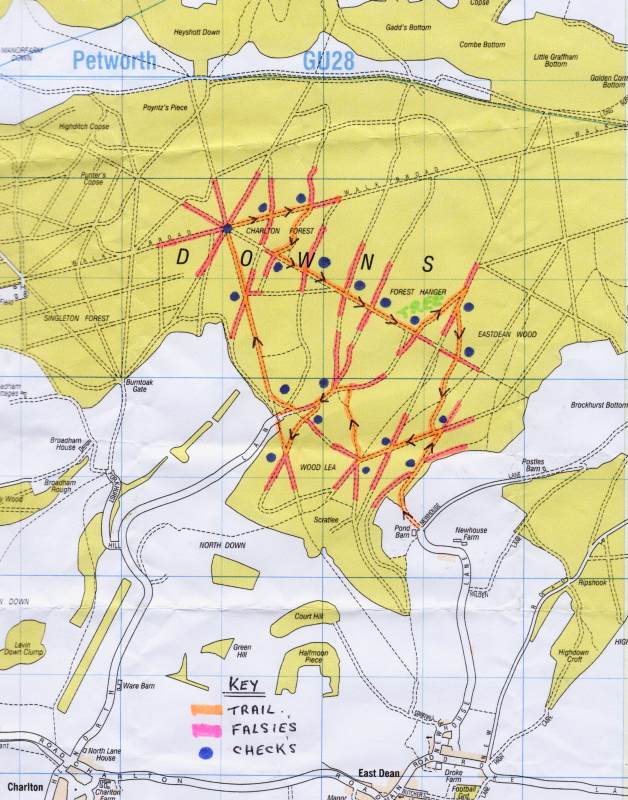



For virgin hares - How to set a trail
Based on and thanks to bicesterh3See also:
Safeguarding
Photographic Policy
Risk Assessment






1. Choose a venue - see (for example):
Different trails around Hampshire and West Sussex &
How often have we used a venue? When did we last lay a trail there?
Check that the venue is suitable at the time of year. E.g. Lambing, Pheasant shooting etc.
No dogs off the lead near sheep!
If you wish to use a new area that's even better.
In any case, please let webmaster and Hash Razor know of your starting point's map reference.
2. Choose a pub - preferably one with decent beer. Then check with the landlord that he is willing to have all his beer drunk for him on the date you have in mind.
3. Roughly plan a route approximately 6 to 7cm long on a 1 : 10000 map (approx 6 - 7 km).
Aim for a run of between 60 - 75 minutes - see this example:

UK users, try this tool to draw your course on an OS map http://maps.the-hug.net
Also see this intro (powerpoint slides).
4. Unless you know the land well, walk your proposed trail first, noting suitable points for checks and making best use of features which may not be apparent from the map alone. Seek out the muddy bits, known as SHIGGY - Hashers love it. Use the geography to confuse the pack's sense of direction and always ensure the pack can't see the start point or pub from any point on the trail otherwise they'll just head straight for it and the greater part of your hard work will be lost.Try to avoid a long straight run in - it encourages the FRBs to show off. Then mark the route on the map.
5. Get hold of the Hash HHH boards from the previous hare and put one at the venue and if required at stratgic junctions.
Don't forget to retrieve them or get the next hares to do it.
6. Buy about 3 1.5 kilo bags of flour or use sawdust if there is snow cover.
Lay the trail preferably on the day before the run and also try to bully someone into giving you some help.
Perhaps place a cache of flour (sawdust) half way round the course.
Time to lay a trail:
3 hours - without help.
2.5 hours - with help.
Regard the hounds as fools who wear bifocals. Lay flour every 20 metres or so on easy clear ground but
reduce this interval to 10 metres or less on rough or overgrown terrain. Lay copious flour when making a
turn on open land. Ask yourself whether you could follow it if you were half blind (as some of us are).
7. Checks are a large clear 'X' and should occur every 300 - 400 metres or so but at varied intervals and,
if possible, at natural check points.
A typical course might have about 20 checks.
The trail should start up again within about 30 - 50 metres and anywhere in a 360° circle, i e "BACK CHECKS" are allowed.
8. When making a FALSE TRAIL the same rule as in para 7 applies but a falsie should be no longer than about 80 - 100 metres before ending with a group of three blobs Any number of false trails can emanate from each check.
9. If your trail changes direction in open country, use an arrow. Use of cowpats to increase colour contrast is recommended as are fence posts or trees in long grass.
10. Possibly include a few loops in your trail to help to keep the pack together. Failing this at least one REGROUP with a sign 'R' at a check to ensure that everyone will wait until the back markers have caught up before recommencing. Another useful device is a 'LADIES' CHECK, a circle with a cross attached, which rather ungallantly assumes the front runners will usually be male. Another method to rein in the FRBs is a FISH-HOOK sign with the number of runners who should return to the tail of the pack.
11. Don't be tempted to make your trail TOO long. A long run makes for a spaced out pack and you won't be thanked for making everyone completely knackered.
12. On the Day itself brief the pack on any unusual hazards and whether dogs should be kept on a lead. Mark an arrow on the ground so that latecomers will know which direction you have taken and not go out on the `in' trail. Make sure all gates are closed after the pack has run through. Be prepared after the run to organise a search party for any lost puppies.
13. Collect evidence of wrong doings and snitch to a Hash Master. and if appropriate, thank the Landlord for his hospitality - you never know, you might get a free pint.
ON, ON!
Footnote.
If you are adventurous why not try to run on private land.
This is not as difficult as it might seem at first sight.
Select a farm on the route and pay it a visit. Tell him ( or her) what your intended route is.
The farmer will advise you if there are any problems on his land with animals or crops, etc.
He will also be able to tell you who owns the other land on your route and who you should approach.
If they are out when you call try the Yellowpages under Farmers and try to clear the route by 'phone.
Remember no landowner can object if you intend using Public Rights of Way across his land but it
is only courteous to inform him that 30 - 40 runners may be descending on his fields containing animals or crops.
Most farmers are very helpful but a few like to be cajoled into the right frame of mind.
Most will say you can go where you like but will warn you about not damaging gates,
fences or hedges. Be prepared to reveal your 'phone No in case of subsequent problems.
Good relations with farmers should be preserved; afterall we will probably wish to make use of their land again in the future.






Contacts |
Notice Board |
Latest Diary |
Hash Trash |
Hash Flash |
Venues |
Links